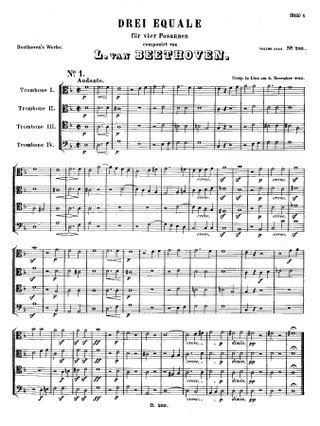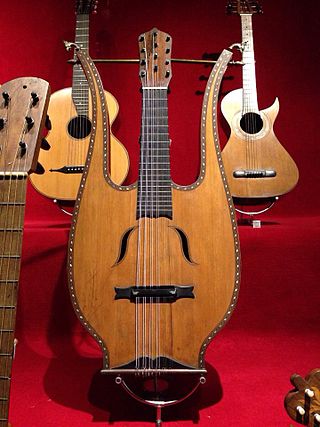
Bagpipes are a woodwind instrument using enclosed reeds fed from a constant reservoir of air in the form of a bag. The Great Highland bagpipes are well known, but people have played bagpipes for centuries throughout large parts of Europe, Northern Africa, Western Asia, around the Persian Gulf and northern parts of South Asia.
A symphonic poem or tone poem is a piece of orchestral music, usually in a single continuous movement, which illustrates or evokes the content of a poem, short story, novel, painting, landscape, or other (non-musical) source. The German term Tondichtung appears to have been first used by the composer Carl Loewe in 1828. The Hungarian composer Franz Liszt first applied the term Symphonische Dichtung to his 13 works in this vein, which commenced in 1848.

The New Grove Dictionary of Music and Musicians is an encyclopedic dictionary of music and musicians. Along with the German-language Die Musik in Geschichte und Gegenwart, it is one of the largest reference works on the history and theory of music. Earlier editions were published under the titles A Dictionary of Music and Musicians, and Grove's Dictionary of Music and Musicians; the work has gone through several editions since the 19th century and is widely used. In recent years it has been made available as an electronic resource called Grove Music Online, which is now an important part of Oxford Music Online.
Switzerland has long had a distinct cultural identity, despite its diversity of German, French, Italian, Romansh and other ethnicities. Religious and folk music dominated the country until the 17th century, with growth in production of other kinds of music occurring slowly.
The recorded history of music in Estonia dates back as far as the 12th century.
Italian music terminology consists of words and phrases used in the discussion of the music of Italy. Some Italian music terms are derived from the common Italian language. Others come from Spanish, or Neapolitan, Sicilian, Sardinian or other regional languages of Italy. The terms listed here describe a genre, song form, dance, instrument, style, quality of music, technique or other important aspect of Italian music.
Jeronimo Bassano was an Italian musician in the Republic of Venice who is notable as the patriarch of a family of musicians: five of his sons, Anthony, Alvise, Jasper, John (Giovanni), and Baptista Bassano, moved from Venice to England to serve in the court of King Henry VIII. They performed as a recorder consort. Jacomo Bassano was his only son to keep his primary residence in Venice. Jeronimo Bassano never moved, and he was listed in Venice as a "Maestro of the trumpets and shawms." He is believed to be the maternal grandfather of composer Giovanni Bassano.
A consort song was a characteristic English song form of the late 16th and early 17th centuries, for solo voice or voices accompanied by a group of instruments, most commonly viols. Although usually in five parts, some early examples of four-part songs exist. It is considered to be the chief representative of a native musical tradition which resisted the onslaught of the italianate madrigal and the English lute ayre, and survived those forms' brilliant but short-lived ascendancy.

An equale or aequale is a musical idiom. It is a piece for equal voices or instruments. In the 18th century the equale became established as a generic term for short, chordal pieces for trombone choirs, usually quartets or trios. The instruments were not necessarily equal in pitch, but formed a closed consort.

A choral symphony is a musical composition for orchestra, choir, and sometimes solo vocalists that, in its internal workings and overall musical architecture, adheres broadly to symphonic musical form. The term "choral symphony" in this context was coined by Hector Berlioz when he described his Roméo et Juliette as such in his five-paragraph introduction to that work. The direct antecedent for the choral symphony is Ludwig van Beethoven's Ninth Symphony. Beethoven's Ninth incorporates part of the Ode an die Freude, a poem by Friedrich Schiller, with text sung by soloists and chorus in the last movement. It is the first example of a major composer's use of the human voice on the same level as instruments in a symphony.
Thematic transformation is a musical technique in which a leitmotif, or theme, is developed by changing the theme by using permutation, augmentation, diminution, and fragmentation. It was primarily developed by Franz Liszt and Hector Berlioz. The technique is essentially one of variation. A basic theme is reprised throughout a musical work, but it undergoes constant transformations and disguises and is made to appear in several contrasting roles. However, the transformations of this theme will always serve the purpose of "unity within variety" that was the architectural role of sonata form in the classical symphony. The difference here is that thematic transformation can accommodate the dramatically charged phrases, highly coloured melodies and atmospheric harmonies favored by the Romantic composers, whereas sonata form was geared more toward the more objective characteristics of absolute music. Also, while thematic transformation is similar to variation, the effect is usually different since the transformed theme has a life of its own and is no longer a sibling to the original theme.
The Schweizer Sackpfeife is a type of bagpipe played in Switzerland from the Middle Ages until around 1700. In German-speaking Switzerland, the pipes are known as "sackpfiff", "sackpfyf", "sagkphiffen", or "sackphiffen". In French-speaking Switzerland it is known as the musette, "cornamusa", or "cornamuse". In the Italian-speaking areas it as known as "zampogna", "piva", "musetto" or "corna musa". In the Romansch language it is called "tudelsac".

A musical instrument of the chordophone family, the lyre-guitar was a type of guitar shaped to look like a lyre, popular as a fad-instrument in the late 1800s. It had six single courses, with a fretboard located between two curved arms recalling the shape of the ancient Greek kithara. It was tuned and played like the conventional guitar.

The baghèt is a bagpipe historically played in Bergamo, corresponding to the region of Lombardy in modern Italy. It is a small double-reeded bagpipe with two drones, associated with rural musicians. The instrument became defunct in the mid-20th century, but is now played by some revivalists.
It is unclear whether Lincolnshire bagpipes refer to a specific type of pipes native to Lincolnshire, England, or to the popularity of a more general form of pipes in the region. Written records of bagpipes being associated with Lincolnshire date back to 1407, but it is difficult to find certain proof that any regional variation of the bagpipe existed which was peculiar to Lincolnshire. Despite the lack of evidence for a uniquely local instrument, it is clear that the bagpipe was enjoyed by the people of Lincolnshire.
Colin Ross was an English folk musician who played fiddle and Northumbrian smallpipes. He was a noted maker of Northumbrian smallpipes, border pipes and Scottish smallpipes, and one of the inventors of the modern Scottish smallpipes.
The mashak is a type of bagpipe found in Northern India, Uttarakhand, Sudurpaschim Province of Nepal and parts of Pakistan and Afghanistan. The pipe was associated with weddings and festive occasions. In India it is historically found in Kumaon and Garhwal in Uttarakhand, Rajasthan and Uttar Pradesh. This bagpipe uses single reeds, and can be played either as a drone or as a melody instrument.
The penorcon is a plucked string instrument with nine courses of double strings, depicted in the treatise Syntagma Musicum by Praetorius. The sides of the instrument are scalloped and sometimes the resonance soundboard has no holes. In relation to the bandora, its body is a little broader, and in length, it is somewhat lesser. Its neck or fingerboard is quite wide.






